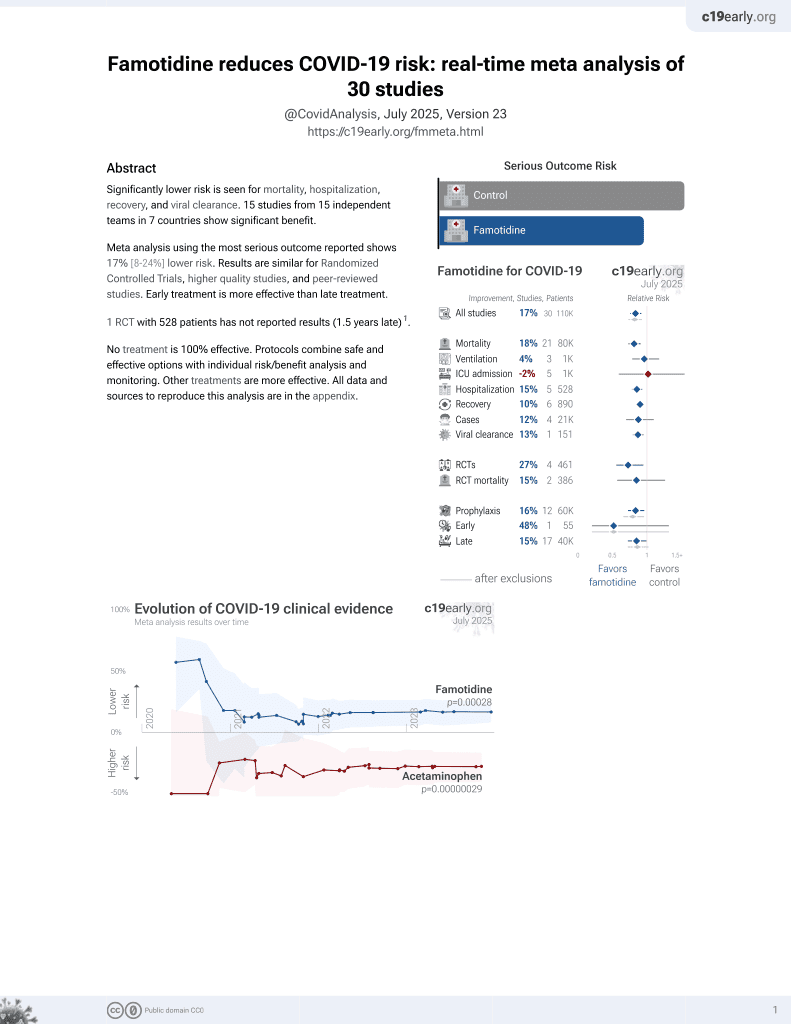
Famotidine Use Is Associated With Improved Clinical Outcomes in Hospitalized COVID-19 Patients: A Propensity Score Matched Retrospective Cohort Study
et al., Gastroenterology, doi:10.1053/j.gastro.2020.05.053, May 2020
Famotidine for COVID-19
29th treatment shown to reduce risk in
October 2021, now with p = 0.00028 from 30 studies, recognized in 2 countries.
No treatment is 100% effective. Protocols
combine treatments.
6,300+ studies for
210+ treatments. c19early.org
|
PSM retrospective 1,620 hospitalized patients in the USA, 84 with existing famotidine use, showing lower risk of combined death/intubation with treatment.
Standard of Care (SOC) for COVID-19 in the study country,
the USA, is very poor with very low average efficacy for approved treatments1.
Only expensive, high-profit treatments were approved for early treatment. Low-cost treatments were excluded, reducing the probability of early treatment due to access and cost barriers, and eliminating complementary and synergistic benefits seen with many low-cost treatments.
Study covers proton pump inhibitors and famotidine.
|
risk of death/intubation, 57.0% lower, HR 0.43, p = 0.02, treatment 8 of 84 (9.5%), control 332 of 1,536 (21.6%), NNT 8.3, adjusted per study, propensity score matching, multivariable, Cox proportional hazards.
|
| Effect extraction follows pre-specified rules prioritizing more serious outcomes. Submit updates |
Freedberg et al., 21 May 2020, retrospective, propensity score matching, USA, peer-reviewed, 15 authors.
Famotidine Use Is Associated With Improved Clinical Outcomes in Hospitalized COVID-19 Patients: A Propensity Score Matched Retrospective Cohort Study
Gastroenterology, doi:10.1053/j.gastro.2020.05.053
See Covering the Cover synopsis on page 803.
Supplementary Material Note: To access the supplementary material accompanying this article, visit the online version of Gastroenterology at www.gastrojournal.org, and at https://doi.org/10.1053/ j.gastro.2020.05.053.
References
Anand, Ziebuhr, Wadhwani, None, Science
Bourinbaiar, Fruhstorfer, None, Life Sci
Chen, Deng, Churchill, None, Cell Stem Cell
Gottschlich, Delegge, Guenter, American Society for Parenteral and Enteral Nutrition
Li, Zhang, Liu, Gu, None, FASEB J
Wu, Liu, Yang, None, Acta Pharm Sin B
DOI record:
{
"DOI": "10.1053/j.gastro.2020.05.053",
"ISSN": [
"0016-5085"
],
"URL": "http://dx.doi.org/10.1053/j.gastro.2020.05.053",
"alternative-id": [
"S0016508520347065"
],
"assertion": [
{
"label": "This article is maintained by",
"name": "publisher",
"value": "Elsevier"
},
{
"label": "Article Title",
"name": "articletitle",
"value": "Famotidine Use Is Associated With Improved Clinical Outcomes in Hospitalized COVID-19 Patients: A Propensity Score Matched Retrospective Cohort Study"
},
{
"label": "Journal Title",
"name": "journaltitle",
"value": "Gastroenterology"
},
{
"label": "CrossRef DOI link to publisher maintained version",
"name": "articlelink",
"value": "https://doi.org/10.1053/j.gastro.2020.05.053"
},
{
"label": "Content Type",
"name": "content_type",
"value": "article"
},
{
"label": "Copyright",
"name": "copyright",
"value": "© 2020 by the AGA Institute"
}
],
"author": [
{
"ORCID": "http://orcid.org/0000-0003-2023-2899",
"affiliation": [],
"authenticated-orcid": false,
"family": "Freedberg",
"given": "Daniel E.",
"sequence": "first"
},
{
"affiliation": [],
"family": "Conigliaro",
"given": "Joseph",
"sequence": "additional"
},
{
"affiliation": [],
"family": "Wang",
"given": "Timothy C.",
"sequence": "additional"
},
{
"affiliation": [],
"family": "Tracey",
"given": "Kevin J.",
"sequence": "additional"
},
{
"affiliation": [],
"family": "Callahan",
"given": "Michael V.",
"sequence": "additional"
},
{
"affiliation": [],
"family": "Abrams",
"given": "Julian A.",
"sequence": "additional"
},
{
"affiliation": [],
"family": "Sobieszczyk",
"given": "Magdalena E.",
"sequence": "additional"
},
{
"affiliation": [],
"family": "Markowitz",
"given": "David D.",
"sequence": "additional"
},
{
"affiliation": [],
"family": "Gupta",
"given": "Aakriti",
"sequence": "additional"
},
{
"affiliation": [],
"family": "O’Donnell",
"given": "Max R.",
"sequence": "additional"
},
{
"affiliation": [],
"family": "Li",
"given": "Jianhua",
"sequence": "additional"
},
{
"affiliation": [],
"family": "Tuveson",
"given": "David A.",
"sequence": "additional"
},
{
"affiliation": [],
"family": "Jin",
"given": "Zhezhen",
"sequence": "additional"
},
{
"affiliation": [],
"family": "Turner",
"given": "William C.",
"sequence": "additional"
},
{
"affiliation": [],
"family": "Landry",
"given": "Donald W.",
"sequence": "additional"
}
],
"container-title": [
"Gastroenterology"
],
"content-domain": {
"crossmark-restriction": true,
"domain": [
"clinicalkey.jp",
"clinicalkey.com",
"gastrojournal.org",
"clinicalkey.es",
"clinicalkey.com.au",
"clinicalkey.fr",
"elsevier.com",
"sciencedirect.com"
]
},
"created": {
"date-parts": [
[
2020,
5,
22
]
],
"date-time": "2020-05-22T01:22:26Z",
"timestamp": 1590110546000
},
"deposited": {
"date-parts": [
[
2021,
5,
19
]
],
"date-time": "2021-05-19T04:27:01Z",
"timestamp": 1621398421000
},
"funder": [
{
"DOI": "10.13039/100000002",
"doi-asserted-by": "publisher",
"name": "National Institutes of Health"
}
],
"indexed": {
"date-parts": [
[
2022,
1,
19
]
],
"date-time": "2022-01-19T16:47:56Z",
"timestamp": 1642610876500
},
"is-referenced-by-count": 130,
"issn-type": [
{
"type": "print",
"value": "0016-5085"
}
],
"issue": "3",
"issued": {
"date-parts": [
[
2020,
9
]
]
},
"journal-issue": {
"issue": "3",
"published-print": {
"date-parts": [
[
2020,
9
]
]
}
},
"language": "en",
"license": [
{
"URL": "https://www.elsevier.com/tdm/userlicense/1.0/",
"content-version": "tdm",
"delay-in-days": 0,
"start": {
"date-parts": [
[
2020,
9,
1
]
],
"date-time": "2020-09-01T00:00:00Z",
"timestamp": 1598918400000
}
}
],
"link": [
{
"URL": "https://api.elsevier.com/content/article/PII:S0016508520347065?httpAccept=text/xml",
"content-type": "text/xml",
"content-version": "vor",
"intended-application": "text-mining"
},
{
"URL": "https://api.elsevier.com/content/article/PII:S0016508520347065?httpAccept=text/plain",
"content-type": "text/plain",
"content-version": "vor",
"intended-application": "text-mining"
}
],
"member": "78",
"original-title": [],
"page": "1129-1131.e3",
"prefix": "10.1053",
"published": {
"date-parts": [
[
2020,
9
]
]
},
"published-print": {
"date-parts": [
[
2020,
9
]
]
},
"publisher": "Elsevier BV",
"reference": [
{
"author": "Gottschlich",
"key": "10.1053/j.gastro.2020.05.053_bib1",
"series-title": "American Society for Parenteral and Enteral Nutrition",
"year": "2007"
},
{
"DOI": "10.1016/S0024-3205(96)00553-X",
"author": "Bourinbaiar",
"doi-asserted-by": "crossref",
"first-page": "PL365",
"journal-title": "Life Sci",
"key": "10.1053/j.gastro.2020.05.053_bib2",
"volume": "59",
"year": "1996"
},
{
"DOI": "10.1016/j.apsb.2020.02.008",
"author": "Wu",
"doi-asserted-by": "crossref",
"first-page": "766",
"journal-title": "Acta Pharm Sin B",
"key": "10.1053/j.gastro.2020.05.053_bib3",
"volume": "10",
"year": "2020"
},
{
"DOI": "10.1126/science.1085658",
"author": "Anand",
"doi-asserted-by": "crossref",
"first-page": "1763",
"journal-title": "Science",
"key": "10.1053/j.gastro.2020.05.053_bib4",
"volume": "300",
"year": "2003"
},
{
"DOI": "10.1016/j.stem.2017.11.003",
"author": "Chen",
"doi-asserted-by": "crossref",
"first-page": "747",
"journal-title": "Cell Stem Cell",
"key": "10.1053/j.gastro.2020.05.053_bib5",
"volume": "21",
"year": "2017"
},
{
"DOI": "10.1096/fj.202000502",
"author": "Li",
"doi-asserted-by": "crossref",
"first-page": "6008",
"journal-title": "FASEB J",
"key": "10.1053/j.gastro.2020.05.053_bib6",
"volume": "34",
"year": "2020"
}
],
"reference-count": 6,
"references-count": 6,
"relation": {},
"score": 1,
"short-container-title": [
"Gastroenterology"
],
"short-title": [],
"source": "Crossref",
"subject": [
"Gastroenterology",
"Hepatology"
],
"subtitle": [],
"title": [
"Famotidine Use Is Associated With Improved Clinical Outcomes in Hospitalized COVID-19 Patients: A Propensity Score Matched Retrospective Cohort Study"
],
"type": "journal-article",
"update-policy": "http://dx.doi.org/10.1016/elsevier_cm_policy",
"volume": "159"
}
